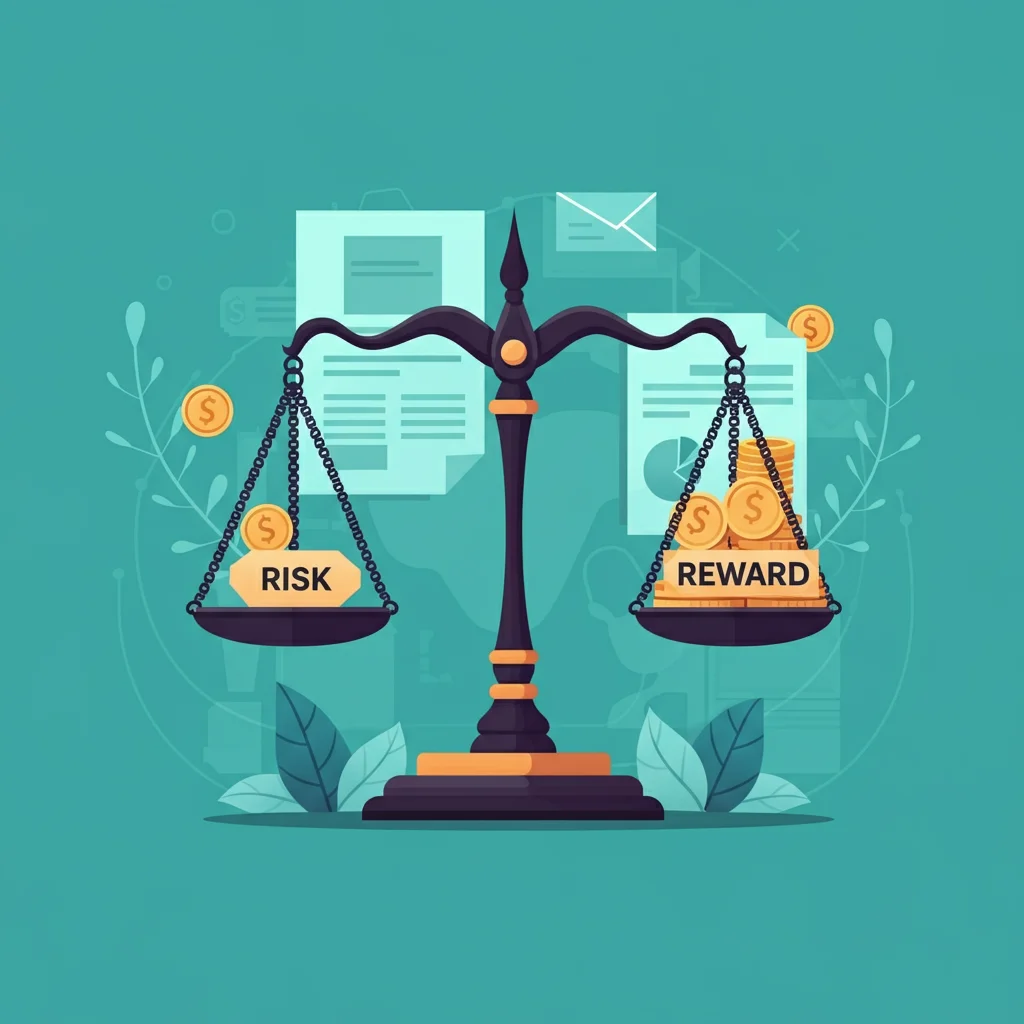Investing is often erroneously painted as a complex game of pure chance, a perilous gamble where outcomes are left to fate. However, truly successful investors—those who consistently build substantial wealth and achieve financial freedom—know better. They profoundly understand that every single financial decision is, in essence, a meticulously calculated balance between inherent risk and potential reward. But what does that truly mean in practical terms? Why are some investors willing to make bold, aggressive moves, while others prefer to proceed with utmost caution and a more conservative approach? How does this impact your online earnings?
Whether you're a seasoned entrepreneur navigating complex markets, a diligent finance student seeking deeper understanding, or a beginner investor eager to responsibly build your first portfolio and start your journey to make money online, this comprehensive guide will thoroughly demystify the fundamental concepts of risk and reward in the dynamic world of investing. We'll meticulously explore what risk truly entails, how to accurately evaluate potential returns, and, most importantly, how to craft intelligent investment strategies precisely tailored to your unique financial goals and personal tolerance for uncertainty. This knowledge is paramount for achieving consistent online earnings.
What Is Risk in Investing? Navigating Uncertainty for Your Online Earning
When we speak about risk in investing, we are fundamentally referring to the potential for losing a portion or all of your invested money, or, alternatively, the chance of achieving a return that is significantly lower than your initial expectations. It embodies the inherent uncertainty that the value of your investment may not perform as you hoped due to a myriad of unforeseen factors such as sudden economic downturns, unforeseen company mismanagement, disruptive technological changes, geopolitical crises, or even shifts in consumer behavior. Understanding these risks is crucial for anyone aiming to earn money online through investments.
However, it's vital to grasp that risk is not purely negative. In the investment universe, risk and return are intrinsically connected—they are two sides of the same coin. Generally, a higher degree of assumed risk is inherently associated with the potential for higher rewards (or returns), while low-risk investments often come with more modest, yet predictable, rewards. This fundamental trade-off is often referred to as the risk-reward ratio.
Key Types of Investment Risks to Be Aware of for Your Online Earnings:
To make truly informed financial decisions and protect your online earnings through investments, you should be acutely aware of the main types of financial risks that can impact your portfolio:
Market Risk (Systematic Risk):
Definition: This is the risk of your investment value fluctuating due to broad changes in the overall financial market, driven by economic, political, or social factors. It affects nearly all investments.
Impact: Equity investments, like individual stocks or stock-based ETFs, are particularly sensitive to market swings and downturns. Diversification within a market doesn't eliminate this risk.
Credit Risk (Default Risk):
Definition: If you invest in bonds (which are essentially loans to a government or corporation), credit risk refers to the chance that the bond issuer might fail to make promised interest payments or, worse, fail to repay the principal amount when it matures.
Impact: Higher-yield (junk) bonds carry higher credit risk. Government bonds from stable countries have very low credit risk.
Liquidity Risk:
Definition: This is the difficulty of selling an asset quickly at its fair market price when you need cash. An illiquid asset might take a long time to sell or require you to accept a significantly lower price.
Impact: Real estate, private equity, or very niche investments (like rare art or collectibles) often carry high liquidity risk. Publicly traded stocks and ETFs typically have low liquidity risk.
Inflation Risk (Purchasing Power Risk):
Definition: Inflation is the general increase in prices and fall in the purchasing power of money over time. Inflation risk is the danger that the returns on your investment won't keep pace with inflation, eroding your future purchasing power.
Impact: Fixed-income investments, such as long-term bonds or fixed annuities, are especially vulnerable since their nominal returns are relatively static, meaning their real (inflation-adjusted) returns can diminish significantly. This can subtly reduce your online earning power over time.
Specific/Company Risk (Unsystematic Risk):
Definition: This risk is unique to a particular company or industry sector. It's the danger that an individual stock or a specific company within your portfolio might perform poorly due to its unique circumstances, such as poor management decisions, a failed product launch, labor disputes, or declining industry trends.
Impact: When you invest in individual stocks, you take on this risk. This is why diversification across multiple companies or into index funds (which spread investments across many companies) is crucial to mitigate this type of risk.
Understanding Reward in Investments: What You Stand to Gain for Your Online Earning
"That sounds scary—is it worth the risk?" The answer invariably depends on your unique financial goals and your capacity to endure potential downsides. The reward in investing refers to the potential profit, gain, or benefit you anticipate receiving from an investment, ideally based on the level of risk you're willing to accept. This is the positive side of your online earning potential.
When evaluating potential returns (rewards), you’ll often encounter several key metrics:
Rate of Return (ROR): This fundamental metric tells you the percentage gain or loss compared to your initial investment over a specific period. It's expressed as a percentage (e.g., a 10% ROR means you gained $10 on a $100 investment).
Risk-Adjusted Returns: This sophisticated metric measures whether the return you received (or expect) is truly justified for the amount of risk you undertook. It helps differentiate between a lucky gain and a strategically sound one. Tools like the Sharpe Ratio or Sortino Ratio help investors evaluate this.
Compounding Returns: This is the magical force of investing, a key component of passive income online. Over time, even seemingly modest annual returns can magnify into substantial wealth due to the power of compounding—earning returns not only on your initial investment but also on the accumulated interest or gains from previous periods. Even lower-risk investments benefit significantly from the long-term effects of compounding.
A Key Rule to Remember in Investing for Online Earning:
One of the golden, enduring rules in the world of investing is this:
The potential for return generally increases with risk, but crucially, not all risks automatically lead to rewards.
Being able to intelligently tell the difference between smart, calculated risks (where the potential reward genuinely justifies the known risk) and reckless, speculative risks (where the odds are stacked against you or the downside is catastrophic) is truly the art of successful investing and a hallmark of a savvy online earner.
How to Evaluate Risk vs. Reward: Your Action Plan for Smarter Online Earning
When making critical decisions about where to invest your hard-earned money, your overarching goal should always be to identify investments where the potential reward significantly outweighs the inherent risk. Here’s a systematic approach you can use to analyze potential investments and optimize your online earnings:
Step 1. Define Your Precise Financial Goals: The Foundation of Your Strategy
Clarity is King: Before you even consider specific investments, articulate your financial goals with crystal clarity. Are you diligently saving for a down payment on a house in 5 years? Are you building a robust retirement fund over 20+ years? Are you creating a college fund for your children?
Time Horizon Impact: Your specific time frame profoundly impacts how much risk you should prudently take. Short-term goals (e.g., saving for a car next year) typically require much lower-risk investments like high-yield savings accounts or Treasury bonds to preserve capital. Conversely, long-term goals (e.g., retirement planning, building passive income online) can generally tolerate higher-risk assets like diversified stocks or ETFs, as there's more time to recover from market downturns.
Step 2. Meticulously Assess Your Personal Risk Tolerance: Understanding Yourself
Ability vs. Willingness: Everyone has a different ability (financial capacity) and willingness (psychological comfort) to cope with investment uncertainty and potential losses. Ask yourself honest questions:
"Can I truly afford to lose a portion of this money without experiencing significant financial hardship or impacting my lifestyle?"
"Am I psychologically comfortable seeing significant fluctuations (ups and downs) in the value of my portfolio, or would that cause immense stress and lead to panic selling?"
Investor Profiles: Some investors genuinely thrive in high-risk, high-reward environments (e.g., crypto trading or start-up investments), actively seeking fast money online, while others fundamentally prefer the stability and predictability of index funds or bonds. Understanding your own investor profile is key to building a sustainable online earning strategy.
Step 3. Strategically Diversify Your Portfolio: Mitigating Risk for Long-Term Online Earning
The Cornerstone of Risk Management: To mitigate the various types of risk while still pursuing meaningful rewards, diversification is absolutely essential. The principle is simple: your investments are less likely to lose significant value at the same time if you thoughtfully spread them across different areas.
Diversification Strategies:
Different Asset Classes: Allocate investments across various asset classes (e.g., stocks, bonds, real estate, commodities, and a small allocation to cryptocurrency).
Geographical Regions: Invest in companies or markets across different geographical regions (domestic and international markets) to reduce country-specific risk.
Industry Sectors: Avoid over-concentration in a single industry sector.
Example: If tech stocks falter due to industry pressure or regulatory changes, potential gains in commodities like gold or stable bond ETFs could help stabilize your overall portfolio, protecting your online earnings.
Step 4. Know the Risk Profile of Each Specific Investment: Do Your Homework
Thorough Due Diligence (DYOR): Before investing a single dollar, do your meticulous homework on what you're buying. Research the asset's historical volatility, the underlying industry trends, the company's financial health, and even the management team's track record. This is especially true for any online earning websites you might invest in.
Utilize Metrics: Use specific financial metrics to anticipate potential risks and growth opportunities.
Beta: A measurement of a stock's volatility in relation to the overall market (a beta of 1.0 means it moves with the market; >1.0 is more volatile; <1.0 is less volatile).
Earnings Reports and Financial Statements: Review a company's fundamental financial health.
Debt-to-Equity Ratio: An indicator of financial leverage.
Liquidity Ratios: To understand how easily an asset can be converted to cash.
Matching Investments to Your Risk Tolerance: Tailoring Your Online Earning Portfolio
Once you've defined your goals and assessed your risk tolerance, you can strategically match these to different types of investments, aligning your approach for optimal online earning.
Low-Risk Investments (Conservative Approach): Prioritizing Capital Preservation
If your priority is preserving capital and you prefer stability over aggressive growth, consider these options:
High-Yield Savings Accounts (HYSAs): Safe, federally insured (up to limits), and highly liquid. Offers modest, but consistent, returns.
Government Bonds (e.g., U.S. Treasuries): Considered highly reliable for steady income, backed by the full faith and credit of the government. However, they are susceptible to inflation risk (if returns don't beat inflation) and interest rate risk.
Certificates of Deposit (CDs): Offer fixed interest rates for a set period.
Dividend-Paying Blue-Chip Stocks: Shares of large, well-established companies with a solid track record of consistent dividend payments and financial stability. These offer a form of passive income online and relatively lower volatility compared to growth stocks.
Suitable for short-term financial goals (1-5 years) and highly risk-averse personalities.
Medium-Risk Investments (Balanced Approach): Growth with Managed Risk
For those aiming for a healthy balance between safety and growth, willing to accept some fluctuations for better online earnings:
Diversified Mutual Funds or ETFs: These are collections of stocks and/or bonds. They offer instant diversification across various industries and asset classes, significantly reducing specific company risk. Examples include balanced funds or ETFs that track broad market indices like the S&P 500. This is a core strategy for building passive income online.
Corporate Bonds: Generally offer higher returns than government bonds but carry some credit risk (the risk that the corporation might default).
Real estate can offer steady rental income alongside potential capital appreciation over the long term. However, it carries liquidity risk and requires significant capital or financing.
High-Risk Investments (Aggressive Approach): Chasing Maximum Online Earnings (with Caution)
For investors seeking aggressive growth, comfortable with significant volatility, and willing to endure higher potential losses:
Growth Stocks & Small-Cap Stocks: Shares of smaller, younger companies that are expected to grow at a faster rate than the broader market. They can see values skyrocket—but also crash dramatically.
Cryptocurrency: Assets like Bitcoin, Ethereum, and various altcoins offer very high potential reward but come with extreme price volatility, regulatory uncertainty, and specific security risks (e.g., investing in crypto safely is crucial). This is a path to fast money online but also fast losses.
Start-Up Investments/Private Equity: Investing directly in new or early-stage businesses. This can generate huge payouts if the business succeeds but comes with an incredibly high failure rate. This is the realm of venture capitalists.
Suitable For: Seasoned investors with significant disposable capital, those with a very long time horizon (10+ years), or individuals with a high risk tolerance who understand the potential for total loss.
Why Risk-Reward Matters in Building Wealth and Your Online Earning Future
Mastering the intricate balance between risk and reward is not merely about making money; it’s fundamentally about making informed, intelligent, and strategic financial choices that are meticulously aligned with your personal goals, values, and psychological comfort. By deeply understanding the intrinsic connection between risk and return, you empower yourself to:
Stay Disciplined During Market Upheavals: You'll understand that short-term volatility is normal and be less likely to panic-sell during downturns.
Eliminate Guesswork and Emotional Decisions: Your investment decisions become data-driven and goal-oriented, rather than driven by fear or greed.
Position Your Portfolio for Long-Term Success: You proactively build a robust portfolio that is designed to grow steadily over time while protecting against undue risk, leading to consistent online earnings.
Achieve Financial Freedom: Ultimately, this balanced approach allows you to achieve your financial goals more confidently and predictably, enabling the lifestyle and passive income online you desire.
Building Smart Habits for the Future: Your Journey to Confident Online Earning
The investment road is rarely smooth, often presenting unexpected turns and bumps. However, by diligently mastering the balance between risk and reward, you will confidently move closer to achieving your financial goals while significantly minimizing unnecessary setbacks. If you’re a beginner, remember to start small (even investing with just $100). Gain confidence by thoroughly researching investments, tracking your performance, and continuously learning from both successes and challenges. Over time, through consistent effort and informed decision-making, you’ll undoubtedly evolve into a savvy, confident investor who can reliably generate online earnings.
Take Action Today! Want to take the guesswork out of your next financial move? Don't delay! Keep learning, stay perpetually informed about market trends, remain connected with reputable financial resources, and cultivate unwavering discipline. By doing so, you'll precisely put yourself on the path to mastering risk vs. reward and confidently taking charge of your financial destiny and your future online earning potential. Your financial freedom awaits!



